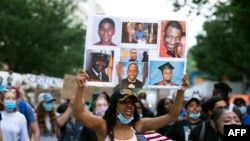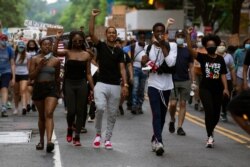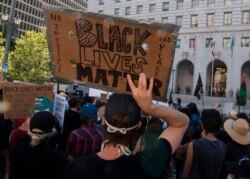With the loud chants of demonstrators nearby, Joyce Johnson gazed at the stone statue of civil rights leader Martin Luther King Jr. in Washington, D.C.
“I wish Dr. King were here now,” she said. “He would be proud to see people from all backgrounds, from all over the country, peacefully protesting for racial justice and equal rights.”
Johnson, a social worker from Richmond, Virginia, traveled to the nation’s capital on Sunday to join thousands of demonstrators marching against the arrest captured on video of George Floyd, the 46-year-old African American man who died in police custody after a white Minneapolis officer held a knee on his neck for almost nine minutes.
Weeks of demonstrations in communities across the county that spontaneously began after Floyd’s death have not been seen in generations. Floyd’s death marks another watershed moment in America's struggle for equal rights and racial justice.
“Protests can galvanize support for meaningful change.” Johnson told VOA.
The current demonstrations take civil rights leader Andrew Young back to the days of racial strife that engulfed the nation during the 1950s and ‘60s.
“I marched all over the country during the civil rights movement, and never in my lifetime have I seen the nation so united around an issue as we see today,” the 88-year old confidant of King told VOA. “Today’s protesters are young, more multiethnic and can use social media to organize. I think we are blessed that the police have shown restraint against protesters, unlike 50 or 60 years ago.”
Young compares the demonstrations following Floyd’s death to the nation’s outrage on March 7, 1965, when hundreds of peaceful demonstrators were brutally beaten and tear-gassed by police at the Edmund Pettus Bridge as they attempted to march from Selma, Alabama, to the state capital of Montgomery, Alabama.
Television news footage of the incident known as “Bloody Sunday” put racial discrimination and violence against blacks at the center of the nation's collective conscience. The violent incident and the protests that followed galvanized support for the passage of the 1965 Voting Rights Act, which eliminated racial discrimination in voting.
Adam Biggs, an instructor of African American studies and U.S. history at the University of South Carolina Lancaster, says today’s clashes between some police and protesters evoke other memories.
“I compare these demonstrations today to the race riots in Harlem, New York, in 1935, the Los Angeles Watts riots in 1965, and unrest in 1992. All of those were triggered by these encounters with police.”
Biggs notes that besides racial injustice, the mass demonstrations are being fueled by high unemployment, high levels of black mortality and racial inequitiesas the nation responds to the coronavirus pandemic.
“We're at the forefront of the spirit of a civil rights campaign. These types of outbursts are rooted in legitimate anger and frustration toward a system that in many ways has failed people,” Biggs said. “These are things (that) sort of suggest that it has a strong potential for longevity, as well. I think it has a potential to be a lot more transformative in some ways, because (of) what's inspiring them.”
Demonstrations spark calls for police reform
In 1992, the videotaped beating of Rodney King, a black man, by several white Los Angeles police officers led to days of demonstrations and civil unrest. The incident again placed the national spotlight on issues of race, justice, police brutality and distrust between minority communities and their local governments.
Continued protests led to reforms such as the hiring of more minority officers. The Los Angeles Police department now publishes use of force and officer-involved-shooting details online, and arrest totals are no longer considered a measure of an officer's success.
In the aftermath of the Floyd’s death, Democratic lawmakers in Congress have proposed similar measures, including a national database on police misconduct and bans on chokeholds and carotid holds around the neck.
The latest demonstrations have increased support toward the Black Lives Matter movement, which led protests after the shooting death of black teenager Michael Brown by a white police office in Ferguson, Missouri, in 2014.
“It is amazing how Black Lives Matter has now become mainstream,” said Allan Lichtman, political historian and professor at American University in Washington. “When it first began, it was largely dismissed as a fringe movement. But not anymore.”
Some political analysts predict the racial justice demonstrations will continue to be transformative and likely impact the outcome of national, state and local elections. Others say the protests will generate enthusiasm among young voters for the November general election.
“The death of George Floyd and other injustices have galvanized young people in ways I haven’t seen in recent memory.” Lichtman told VOA. “It’s hard to predict the turnout of young people in the presidential election, but if it's going to increase, it’s going to happen this November.”











